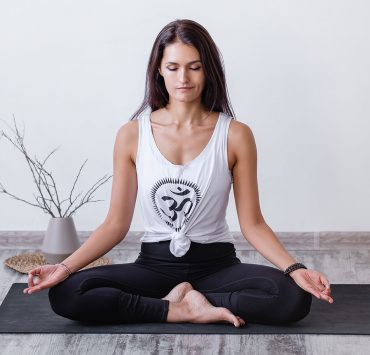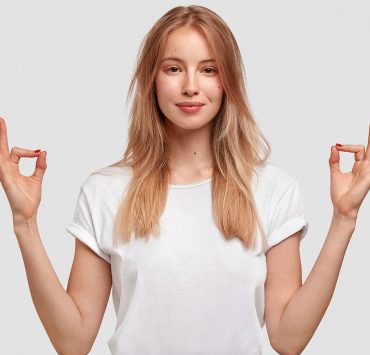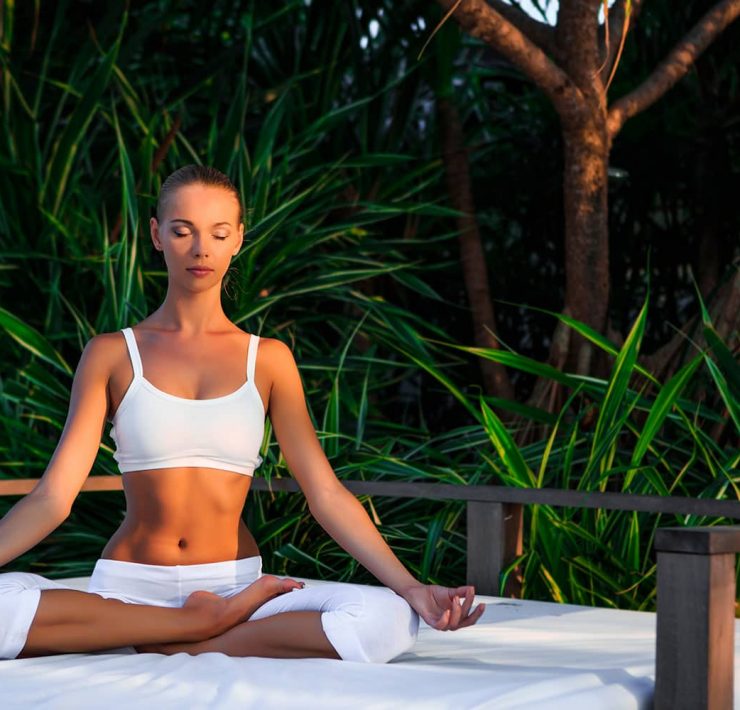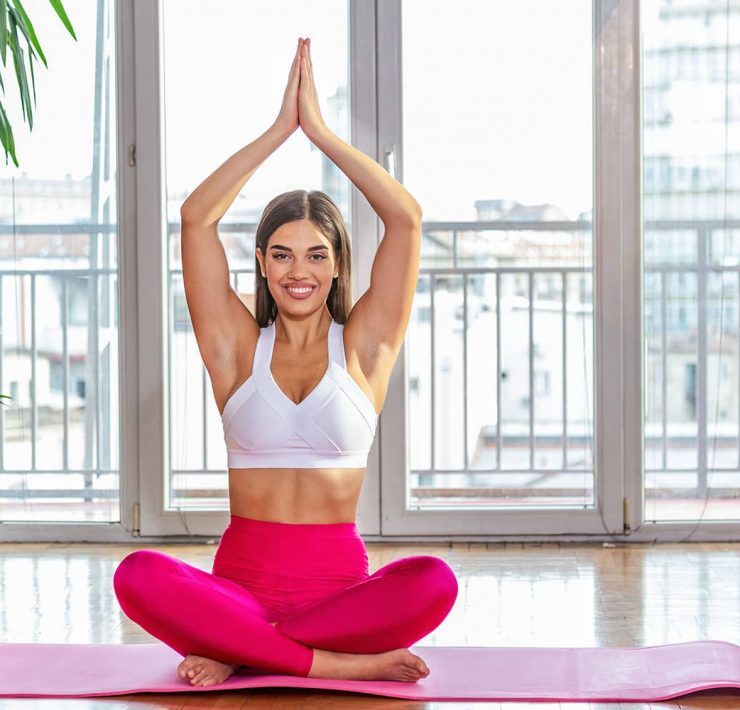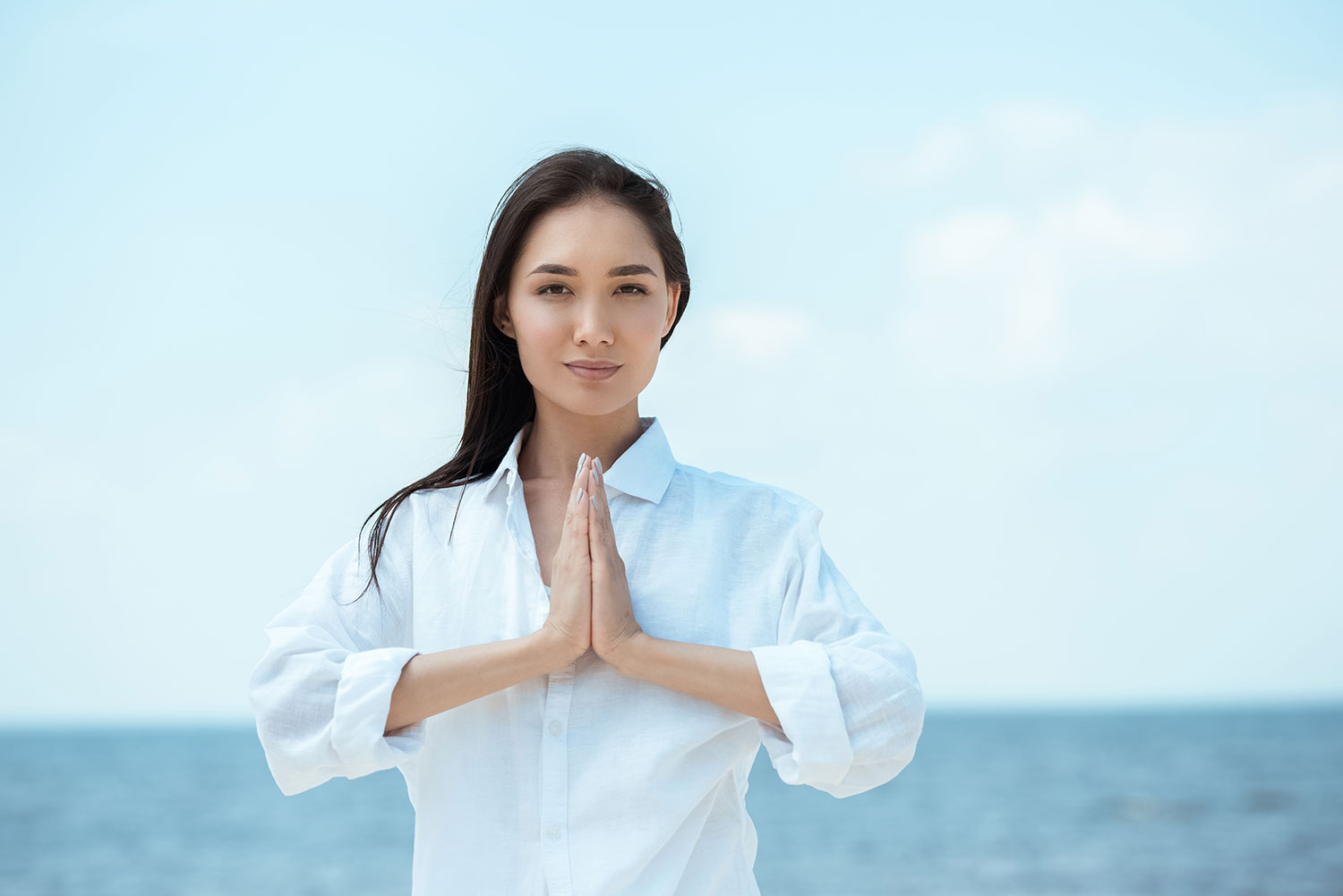
As a trained yoga professional and Ayurvedic practitioner, Donna goes…
“Hands in prayer position” and “hands together at your heart center” are cues in almost every yoga class. This simple act of placing your palms together at the center of your chest can be a sign of gratitude. It’s also a way to stabilize yourself or give your arms a rest during challenging poses.
The deeper meaning and benefits of this hand position go beyond the physical yoga poses. Its formal name is Anjali Mudra. A mudra is a hand gesture that influences energy in the body. The word Anjali (pronounced “un-juh-lee”) means offering. Anjali mudra is a posture of prayer or submission, and also of gratitude.
There are hundreds of mudras. In yoga, mudras are used during meditation or as a part of a yoga pose. The word mudra means seal or mark, so you will often see mudras named this way. Heart Seal, Life Force Seal, and Consciousness Seal are common mudras in meditation.
Mudras help you tap into your subtle body–the combination of the mind, the intellect, and the ego. Each part of the hand is connected to a different part of the mind or body. Shaping your fingers and hand into a mudra can activate other parts of the body. Mudras can guide the flow of energy to your brain and even alter your mood.
How is it possible to change your state of mind just by moving your hands? That’s what the mind-body connection is all about. Each finger represents one of the five different elements in the universe. The thumb is fire, the forefinger is air, the middle finger is connection, the ring finger is earth, and the pinky finger is water.
The fingers also have a connection with consciousness. Universal consciousness is represented by the thumb, and the individual consciousness is represented by the forefinger.
Mudras have been around for thousands of years. They originated in ancient India and are still spiritual practices in Hinduism and Buddhism. In art and sculptures, the Buddha is often shown with his hands in different mudras. The mudras highlight different parts of Buddha’s philosophy: meditation, teaching, and generosity.
Dhyana mudra (hands gently resting on your lap) is the meditation mudra. The teaching mudra, Vitarka mudra, is performed by placing the right hand at chest level and joining the thumb and forefinger in a circle. Generosity is signified by Varada mudra. The right hand is extended, palm facing up and fingers pointing downwards. The left hand rests face up in the lap.
Anjali mudra also has physical benefits, like increasing strength and flexibility in the arm and wrist joints. This mudra calms your mind and allows you to focus on your breath. Balanced breathing allows good circulation of oxygen from the heart.
Now that you know the basics of mudras, let’s take a deeper look at Anjali mudra.
Anjali Mudra How-To
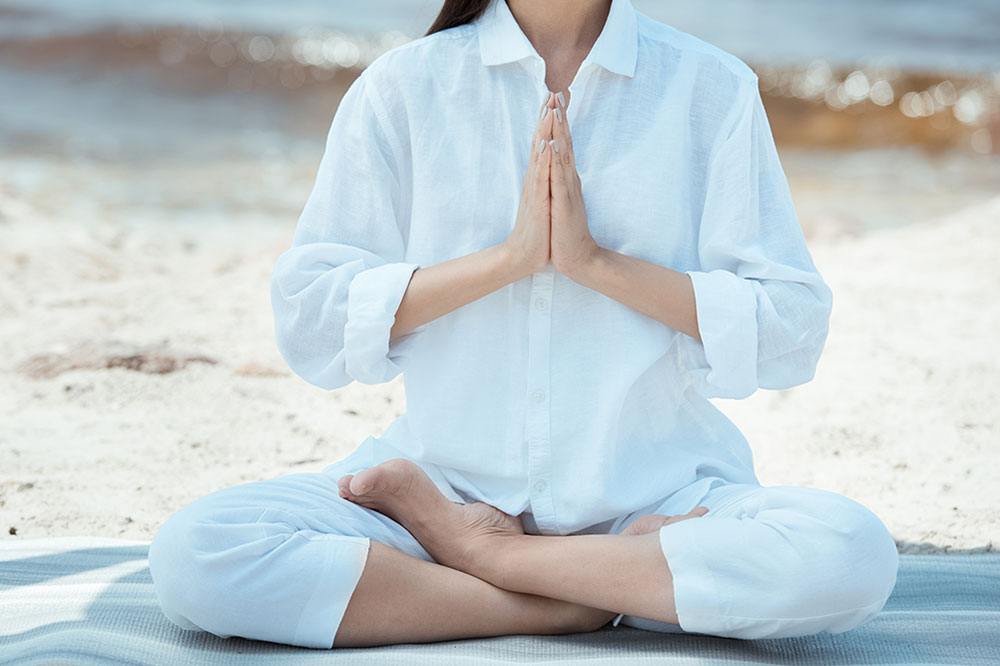
Whether you’ve done Anjali mudra once or a hundred times, it’s worth reviewing this mudra’s proper setup. Sit in a comfortable position, with your legs crossed or tucked under your hips. Make sure you’re not slouching–straighten your spine and tuck your chin slightly. Tucking your chin will lengthen the back of your neck.
Bring your palms together to touch at the center of your chest. Press your thumbs gently into the bone at the center of your ribcage–the sternum. Draw your shoulder blades together and broaden your chest. Bring your elbows forward slightly, so they are in alignment with your wrists. Take several breaths here, pressing your hands gently together.
Anjali mudra is a physical balancing act, bringing the right and left sides of the body together. It also connects the right and left sides of the self–consciousness. In yogic philosophy, the right and left sides of the self are opposites. The right side represents masculinity, logic, and strength. The right side represents the feminine, intuitive, and tender qualities.
We all have each of these qualities, and Anjali mudra helps balance them. Balancing has a calming and grounding effect. It can promote focus and concentration. Connecting the two sides of the body allows energy to easily flow between them.
Anjali Mudra and Meditation
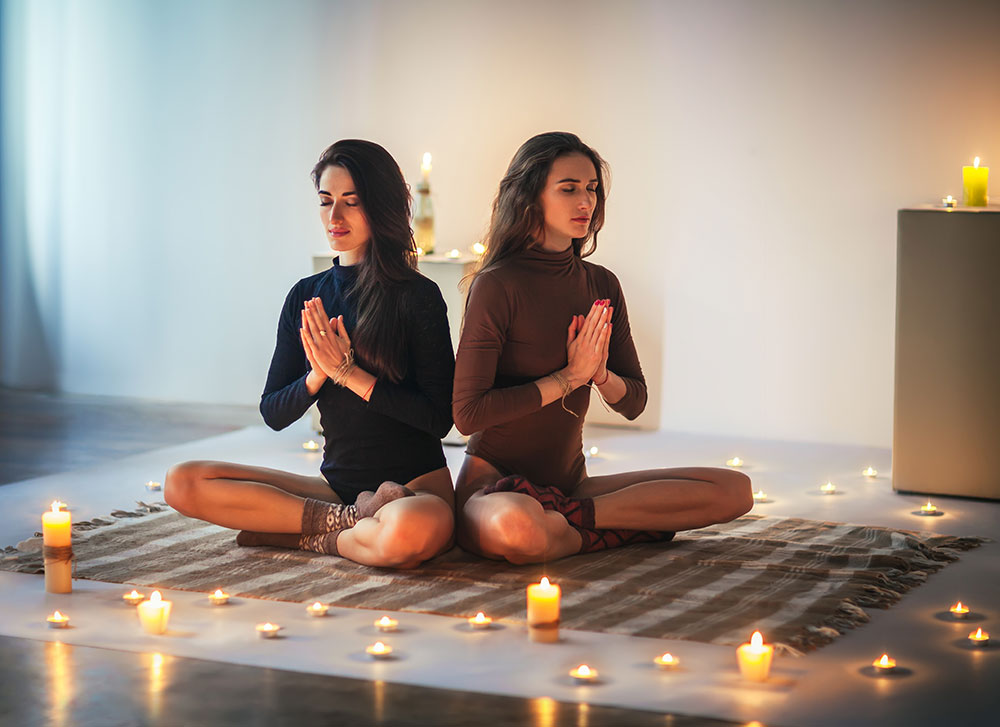
Meditation is beneficial in so many ways. Yoga and meditation share a deep connection, originating from yoga’s roots as a spiritual and mystical practice. Now, meditation is mainly used for relaxation, but it is also a way to tap into yourself. Anjali mudra is an easy way to deepen your meditation practice.
A downside of modern life is that we’re so busy all the time. Our minds are cluttered and always thinking about the next thing on the to-do list. Of course, meditation helps slow down the mind, but sometimes it’s hard to calm the mind enough to meditate! That’s where Anjali mudra can help. If you need help grounding and focusing, try doing Anjali mudra the next time you meditate.
Integrating Anjali mudra with meditation will allow you to focus and calm the chatter in your mind. Once the mind is quiet, you can look a little deeper. Placing your hands at your heart center opens up the heart chakra and the flow of energy throughout your body.
This can have a positive effect on your emotional state. Even if you’re practicing or meditating alone, Anjali mudra can bring up feelings of love and thankfulness. The mudra can even bring a sense of harmony and calm to your body.
Anjali mudra and the Heart Chakra
Chakras are the body’s seven energy centers, which are located along the center of the body from the pelvis to the top of the head. The fourth chakra, the heart chakra, is located in the center of the chest. On a physical level, the heart chakra is connected to the heart, the thymus gland, the lungs, and the breasts. The thymus is located behind the sternum and plays an essential role in immunity.
On a spiritual level, the heart chakra is associated with spiritual awareness, love, compassion, and forgiveness. The heart chakra is the central chakra, where the physical and spiritual come together. When the heart chakra is blocked or imbalanced, negative feelings like jealousy, grief, and grudges towards others can arise.
Anjali mudra can activate and balance the heart chakra. Bringing the right and left sides of the body together restores the body’s harmony. When your hands are connected, energy can flow freely throughout the body. This is why Anjali mudra is so calming and grounding.
Anjali Mudra and Namaste
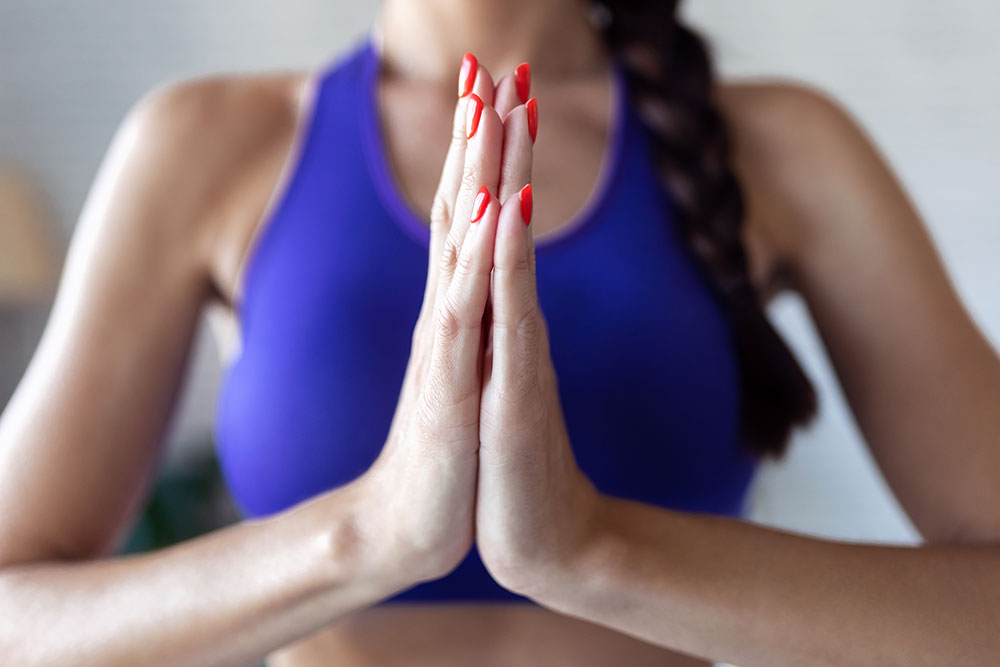
Namaste is most people’s first introduction to Anjali mudra. Outside of yoga, namaste is a respectful way to say “hello.” Traditionally, namaste is said with a gentle head bow and hands in Anjali mudra. Since the word Anjali means offering, it makes sense that it’s used as a sign of respect and gratitude.
Together, namaste and Anjali mudra are done at the end of most western yoga classes. Saying namaste while bowing your head is a way of thanking the teacher and the other students in your class.
Aside from gratitude, namaste symbolizes many other qualities, like divinity and light. Anjali mudra is a perfect fit for divinity. The gesture brings the right and left sides of the body into divine harmony. Anjali mudra can also be a representation of your inner light–the spirit in your heart.
This mudra is so powerful and well-known that some yogis use it for communication. At silent meditation retreats, Anjali mudra is the perfect way to acknowledge others without using words. The simple gesture is a unique way of saying “may I pass by,” “hello,” and “thank you.”
Anjali Mudra in Practice
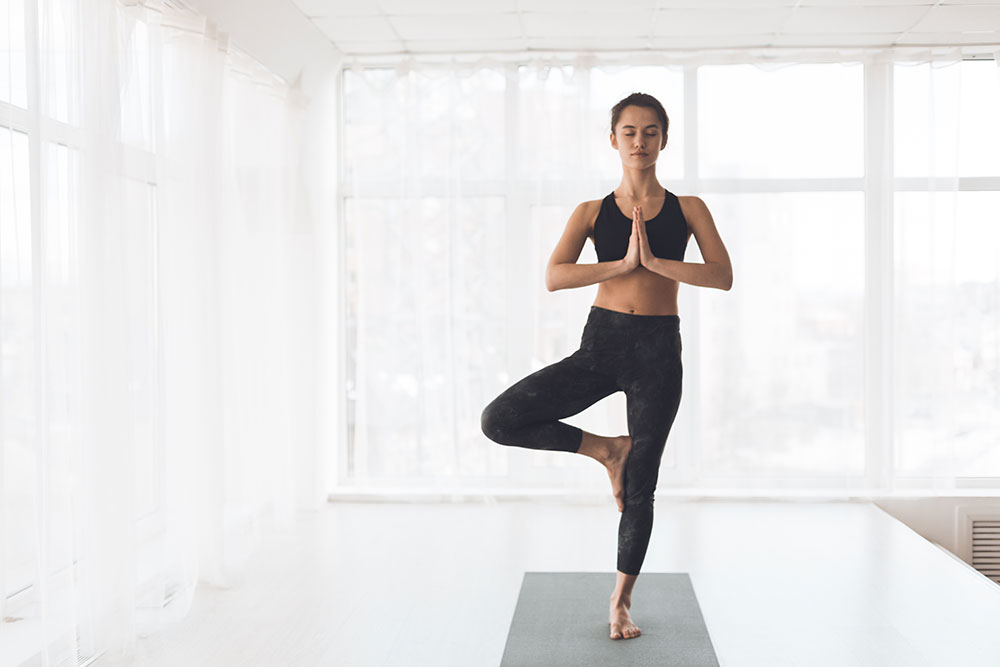
Outside of meditation, Anjali mudra is part of many yoga poses. Mountain pose (tadasana) is one of the most common poses that incorporates Anjali mudra. Mountain pose is the beginning and end to sun salutations–the pose where you stop to catch your breath and recenter. Using Anjali mudra here is a great way to stabilize and feel grounded before returning to your flow.
Tree pose is a balancing pose where your hands and arms can provide stability. One foot is planted firmly on the ground, and the other foot is pressed against your inner calf or thigh. Anjali mudra is useful for beginners or anyone who needs a little extra stability. Joining the hands at your heart center draws both sides of the body toward the midline. This will keep you stable and strong.
The strength and stability of Anjali mudra are very beneficial in poses with active twisting. In these poses, the twist should start at your core. The Anjali mudra hand position allows you to twist deeper while sending energy along your spine. It works the same for moving twists, like bringing opposite elbows to knees in boat pose.
In poses like revolved crescent lunge and chair twists, you can touch your elbow to the outside of the opposite knee. This position gives you leverage to deepen the twist and lengthen your spine. This strengthens and prepares your body for advanced poses like side crow and side plank.
Anjali mudra also works with your hands raised above your head. To do this, raise your hands so your arms are framing the sides of your face. Draw your palms together to touch, just as you would if they were at heart center. Imagine a long line of energy between your heart and your lifted hands. This variation is common in tree pose, warrior I, crescent lunge, and any other pose with raised arms.
In addition to its strengthening and grounding qualities, Anjali mudra can also bring much-needed relief during challenging poses. In the full expression of chair pose, arms are raised alongside your face. Chair pose is an intense pose, and it feels wonderful to give your arms a break in Anjali mudra.
Anjali mudra is a helpful variation in balancing poses like airplane or warrior III if your arms are fatigued. Bringing your hands to your heart center allows you to focus on balance and strength in the lower body.
An advanced variation of Anjali mudra is the reverse prayer position–Pashchima Namaskarasana. This pose is essentially Anjali mudra with your hands behind your back. Pashchima means backside, and Namaskarasana means greeting pose.
To do this mudra, join your palms behind your back, with your fingers facing down. On an inhale, rotate your wrists so your fingers come towards your spine. Lift your hands and continue rotating until your pinky fingers are along your spine. This pose can be challenging for anyone with tight shoulders, and it’s ok if your palms don’t touch completely–don’t force anything!
Aside from grounding and stability, reverse Anjali mudra is highly beneficial for the body. It strengthens and opens the wrists, hands, and forearms. It can also stretch and relieve tension across the collarbone, shoulders, and chest–a nice way to relax after a long day working at a desk.
Deepen Your Practice With Anjali Mudra
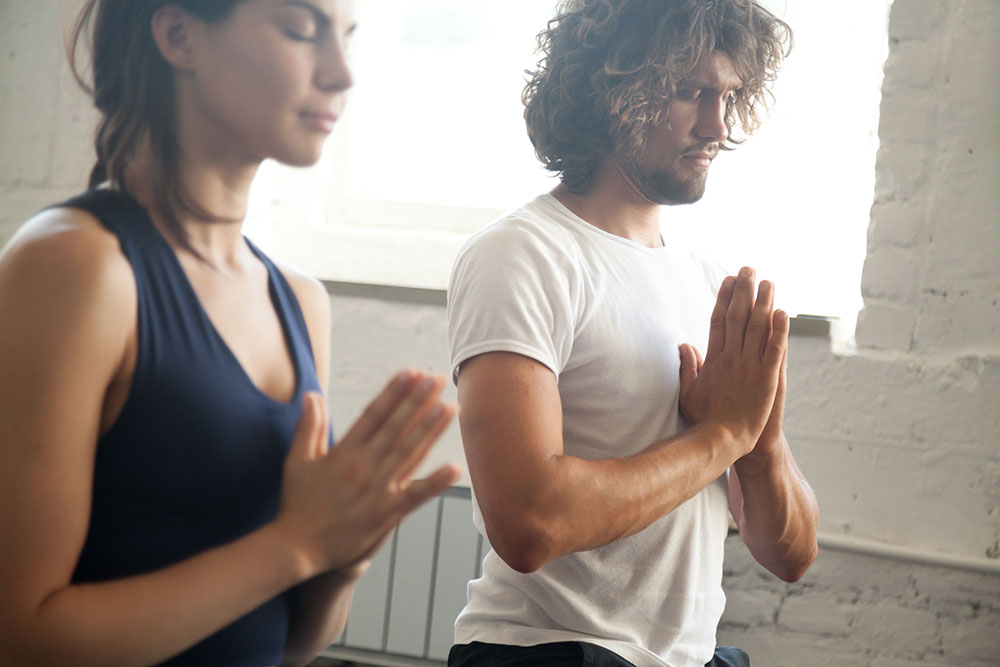
There are so many ways to receive Anjali mudra’s benefits. Try it the next time you say “thank you” to a friend or coworker. If you’re in a stressful situation, like a traffic jam or long line at the grocery store, bring your hands together at your heart center. Take a deep breath and remember Ajali mudra’s calming effects.
If it seems like negative feelings are dominating, your heart chakra may be blocked. Meditate with your hands in Anjali mudra. This may open up your heart and balance your emotions.
Return to Anjali mudra when you need some grounding and balance during a yoga class. It balances your body physically by drawing everything in towards the midline. It centers your focus, so you can remain stable in your pose.
If Anjali mudra speaks to you, learn more about the other mudras. You may find another that helps you feel energized or empowered. Ask your friends and other yogis how they use Anjali mudra. Their experience may be different from yours.
Have you found other ways to bring Anjali mudra into your life? Does it benefit you in unexpected ways? Please share your thoughts with us in the comments!
What's Your Reaction?
As a trained yoga professional and Ayurvedic practitioner, Donna goes far beyond just writing about holistic concepts. With your health and wellness in mind, she happily provides an abundance of thoughtful and well-written information.






